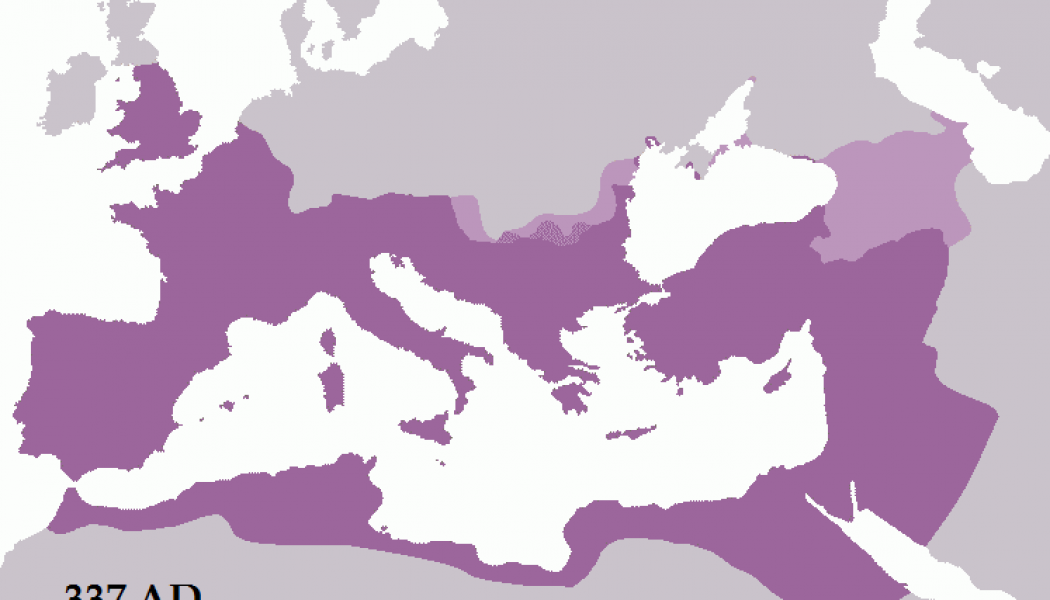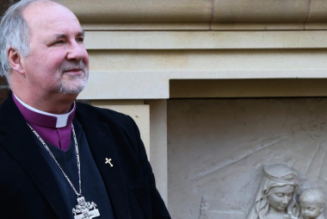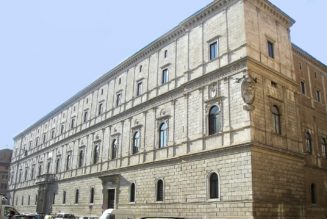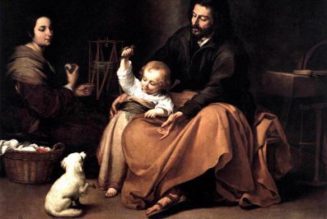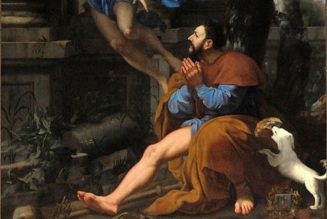Editor’s Note: At a recent faculty meeting day, a lunch conversation about how to divide and name different periods of history led to Lucas Lopes, Freshman Core teacher, inviting Lionel Yaceczko to give the following talk to his class as they were studying the period between the Roman Empire and Medieval Christendom.
In the second century of the Christian Aera, the empire of Rome comprehended the fairest part of the earth, and the most civilized portion of mankind. The frontiers of that extensive monarchy were guarded by ancient renown and disciplined valor. The gentle but powerful influence of laws and manners had gradually cemented the union of the provinces. Their peaceful inhabitants enjoyed and abused the advantages of wealth and luxury. The image of a free constitution was preserved with decent reverence: the Roman senate appeared to possess the sovereign authority, and devolved on the emperors all the executive powers of government. During a happy period of more than fourscore years, the public administration was conducted by the virtue and abilities of Nerva, Trajan, Hadrian, and the two Antonines. It is the design of this, and of the two succeeding chapters, to describe the prosperous condition of their empire; and after wards, from the death of Marcus Antoninus, to deduce the most important circumstances of its decline and fall; a revolution which will ever be remembered, and is still felt by the nations of the earth. —Edward Gibbon, History of the Decline and Fall of the Roman Empire, Chapter 1.

The Roman Empire at the height of its power.
The Dark Ages?
What happened in the “dark ages,” and why do we call them dark? When did they occur? For most of us, the idea of darkness is opposed to light as evil to good. I sat at the piano the other night with my five-year-old son. We were both playing our own thing on different parts of the keyboard. Although I was not lucky enough to have a piano in my house as a kid, I remembered being five and loving the black keys best—I don’t know why—and I asked him, “Which keys do you like better, the white ones or the black ones?”
Without a second’s hesitation, he said, “The white ones.” He replies to all questions without a second’s hesitation. It’s a bad tendency that all boys share, but some of us have to struggle harder than others to get it under control in order to become men.
“Why?”
“Because light is good, and darkness is bad.”
In the Hebrew book of Genesis we read that when God made heaven and earth, shadows pressed upon all creation. Now Genesis is a Greek word that simply means “beginning” in English. This is the beginning of the beginning. In the beginning God created the heaven and the earth. And the earth was without form, and void; and darkness was upon the face of the deep. And the Spirit of God moved upon the face of the waters. (Gen. 1.1–2)
Not a moment was spared but God said:
Let there be light: and there was light. And God saw the light, that it was good: and God divided the light from the darkness. (Gen. 1.3–4)
And we are told two things about the light. One, it is the first thing about which we are told that it is good. Two, it is separated from the darkness. And so we learn to sense this opposition. The first paragraph of the first chapter of John’s Gospel tells us that God was himself the light of mankind and that he prevailed over the darkness that tried to overcome this light.
In him was life; and the life was the light of men. And the light shineth in darkness; and the darkness comprehended it not. (Jn. 1.4–5)
But why is a period of history called a “dark” age? And what is the period that we call today the “Dark Ages”? I hope to convince you right now that the period we call the “Dark Ages,” in fact the period which most historians today have already for decades been calling something else, is not a dark age at all. But I will return to that point after I have described a dark age, properly understood .
The Real (Greek) Dark Ages
The Greek Dark Ages are the period between the Mycenaean Period and the Archaic Period, and they range from about 1100–800 BC. They differ from the period that came before, the Mycenaean Period, in that they lack a principle of unity. The Mycenaean Greeks are the Greeks from any cities that flourished in the few centuries before 1100 BC, who adopted styles of organization, clothing, ornament, tools, and government from the kings of Mycenae, in addition to the very important fact that they paid taxes to the king of the local hilltop palace, or even that a group of kings paid taxes to a greater king. The Mycenaean Greeks had writing, too, although the surviving texts are inscriptions of very practical matters—e.g., records of how much property this or that king owned. So the Mycenaean Period had two things: writing and a principle of unity.
The Archaic period follows the Greek Dark Ages. In sharp contrast to the period preceding it, the Archaic Period left behind a plentiful body of literature. The single most important event that defines the Archaic Period for us is the composition of the epic literature, and especially the poems we attribute to Homer: The Iliad, The Odyssey, and the Homeric Hymns. The Archaic Period did have some principles of unity, some other artistic and cultural characteristics that linked together many Greek cities across a wide swath of land centered around the Aegean Sea. For example, the Panhellenic Games brought all Greeks together in times of peace—they even created a little pocket of peace in the midst of wars. The Delphic Oracle brought Greeks and non-Greeks together, like an ancient United Nations, seeking wisdom and the help of the gods. And the Persian Wars provided the Greeks with a foreign enemy against which they could define themselves. But the literary foundation of all subsequent Greek civilization, which would survive to this very day and continue to influence new creative works of art, was most important.
So we see two important things that the Greek Dark Ages lacked: a principle of unity and written records. That is why even today we still label this period “dark.” There simply are no written sources for us to study the period directly. There has been much archaeological discovery of new evidence from that period, but without written records, it is sometimes impossible for us even to explain something as simple as the different functions of two clay pots.
Is Medieval the Same as Dark?
So what are we talking about when we talk about “The Dark Ages”? What is the period of time? Like the Greek Dark Ages, the Medieval Dark Ages is sandwiched between two periods full of written sources and their own unique principle of unity. The original idea of The Dark Ages came from men who thought themselves to be “enlightened.” In fact, for them, the period of the Roman Empire stood in the distant past like a lighthouse that they could see across a long, dark ocean, and they themselves were living in what they called an Age of Enlightenment. The most influential historian of the Age of Enlightenment, the man most responsible for our adoption of the idea of “The Dark Ages,” was Edward Gibbon.

Edward Gibbon (1737-1794)
Edward Gibbon wrote The History of the Decline and Fall of the Roman Empire over a span of many years, but he began to publish it in volumes in the year 1776. For Gibbon, the most glorious and most perfect age of man, as he tells us in his very first chapter, which I quoted at the beginning of this essay, was the second century of our era. So all that time from about AD 150 onward, perhaps even to Gibbon’s own year of 1776, is what Gibbon meant by “The Dark Ages,” a term he uses explicitly only a handful of times in his history, but an idea which he promoted very clearly from the first page of his work. For Gibbon, and for many thinkers of The Enlightenment, all those centuries during which Christianity and the bishops of the Catholic Church exercised their greatest influence over the governments and societies of Europe, were “dark.”
We can immediately sense that we are dealing with a much different definition of “dark,” here. Now we are back to the moral sense of darkness: badness. Even the name “Enlightenment” implies a condemnation of the state of European society before it began. For Gibbon and many others, the influence of the Catholic Church was bad for civilization.

The Western (Red) and Eastern (Purple) halves of the Roman Empire.
1500 Years of Darkness
Once you accept that the influence of the Catholic Church was bad, it is obvious and necessary to accept that it began and rose at the expense of something else declining and falling. So, for Gibbon, it was obvious that the Christian Era began with a flourishing Roman Empire, and was, as he said in Chapter Three, “possibly the only period of history in which the happiness of a great people was the sole object of government.” Then, according to Gibbon, it declined and fell, until, in AD 476, the last Western Roman Emperor, Romulus Augustulus, died, ushering in what most historians today call the Middle Ages. Gibbon still has a thousand years of Roman Empire to describe, however, until he gets to 1453, the fall of Constantinople and the last Eastern Roman Emperor, Constantine XI. For Gibbon, this whole period of about 1500 years saw “the fairest part of the earth, and the most civilized portion of mankind,” as he called it, decline into chaos and finally into total disintegration. At the same time, the Church’s influence grew and took over the Roman Empire.
But did Gibbon start with the facts, and then draw his ideas about good and bad from them? Or did he start with his ideas about good and bad, and then try to fit the facts into them? The consensus of historians today, both sympathizers to Christianity and those who show no bias for or against Christianity, seems to be that if you put the facts first, you get a much different understanding of “The Dark Ages,” and indeed you can no longer even use the term.
Let us return to the more scientific definition of “dark,” the one which makes no judgment of good or bad, but simply indicates whether we have evidence for the study of that period. How much evidence do we have for the study of the period from about AD 150 to about AD 1776? Shakespeare (1600s) and Dante (1300s) alone are enough to show that there is not only surviving written evidence, but even surviving highly polished literature—what’s more, there are two of perhaps the top ten or even top five most influential writers in the history of the world. But how far back should we push the end of the Dark Ages? Surely we have to push it back at least to the 800s, when Charlemagne resurrected the Roman Empire, and began what historians today call the “Carolingian Renaissance,” a period in which many works of literature were written that survive today.
What’s Left from These Later “Dark Ages”
So we are left with a period from about 150–800. This is the period that historians in the 19th century, and even in the 20th century, agreed to consider the Dark Ages. But was it because there were no sources for the study of the period? As a matter of fact, about 99% of the literature written by authors prior to the year AD 300 is lost. So we hardly have any of the literature that was written in the Golden Age of Greek literature and the Golden Age of Latin literature. But we don’t call them dark ages because those works of literature are so great and still influence so much of the literature that is being produced in the world today, including Hollywood productions like Troy and 300.
On the other hand, nearly all of St Augustine’s works survive today, and the same is true of many of the authors known as the Fathers of the Church. Augustine lived in the 300s and 400s, in what theologians call the Golden Age of Patristic Literature. Thousands and thousands of pages of literature from the period from 150–800 survive today—vastly more than the literature of the Classical period. In fact, so much literature from the so-called Dark Ages survived that even some of the bad stuff survived. Unlike the Classical periods, when only the best of the best survived, in the so-called Dark Ages so much literature survived that some of it survived not because it was great and influential, but merely by accident.

The shrinking Western Empire
Specialization: Classics and Theology
So why don’t we know about this stuff? Two reasons. First, in the 19th and 20th centuries, the successors of Edward Gibbon were the Classicists. The Classicists were (and are) the academics who study the Classical Periods of Greek and Roman history (about 500–323 BC for the Greeks; about 150 BC–AD 150 for the Romans). The discipline of “Classics” as we know it today arose in the 19th century and followed Gibbon’s prejudice that what came after the Classical Period was not worth their attention.
Then there are the theologians. Christian theologians have always been interested in the Golden Age of Patristic literature for obvious reasons. So they have studied the period of 150–800 AD. But theologians don’t learn to read Latin and Greek. Hardly anyone except a classicist does. So classicists could read the literature, but didn’t want to, and theologians wanted to, but couldn’t. So it happened that this notion of 150–800 being called the Dark Ages took hold, a millennium and more after it happened, as a result of ignorance and taste.
Cause and Effect Reconsidered
But after all the Roman Empire did fall, and there were causes. Gibbon was right about them to some extent. But if he was wrong about a big assumption, it was perhaps the most common mistake that all historians make, whether we study ancient history or recent history (also known as the daily news) or anything in between. It is the assumption that because something did happen, then it had to happen.
In other words, the fact that something happened tells us that whatever happened before it was already leading up to it. So if an empire falls, and an empire began, then we can surely look at the years in the middle and see how it passed its peak and declined toward its end. But this is not always the case. Not every result is natural. Some are merely actual. An accidental footstep can destroy a massive anthill built by thousands over many lifetimes just as much as the slow erosion of wind and rain can.
And that’s precisely what happened with the Roman Empire. The Empire in the East came crashing down under the violent shocks of outside invaders in 1453. No one questions whether 1453 was the end of Constantinople—it had its name changed!—and the Eastern Empire. But so did the Empire in the West. When wave upon wave of foreign nations invaded the Western Roman Empire in the 400s AD, the Senate and the Roman People ceased to be sovereign of a united political entity. But the stories of all the pieces of that Empire kept on going, threads of the same larger story, all the way into the Medieval Period. And historians for half a century now, beginning in the 1970s, have not been calling that period the Dark Ages. They have been calling it Late Antiquity.

Courtesy of Wikimedia
